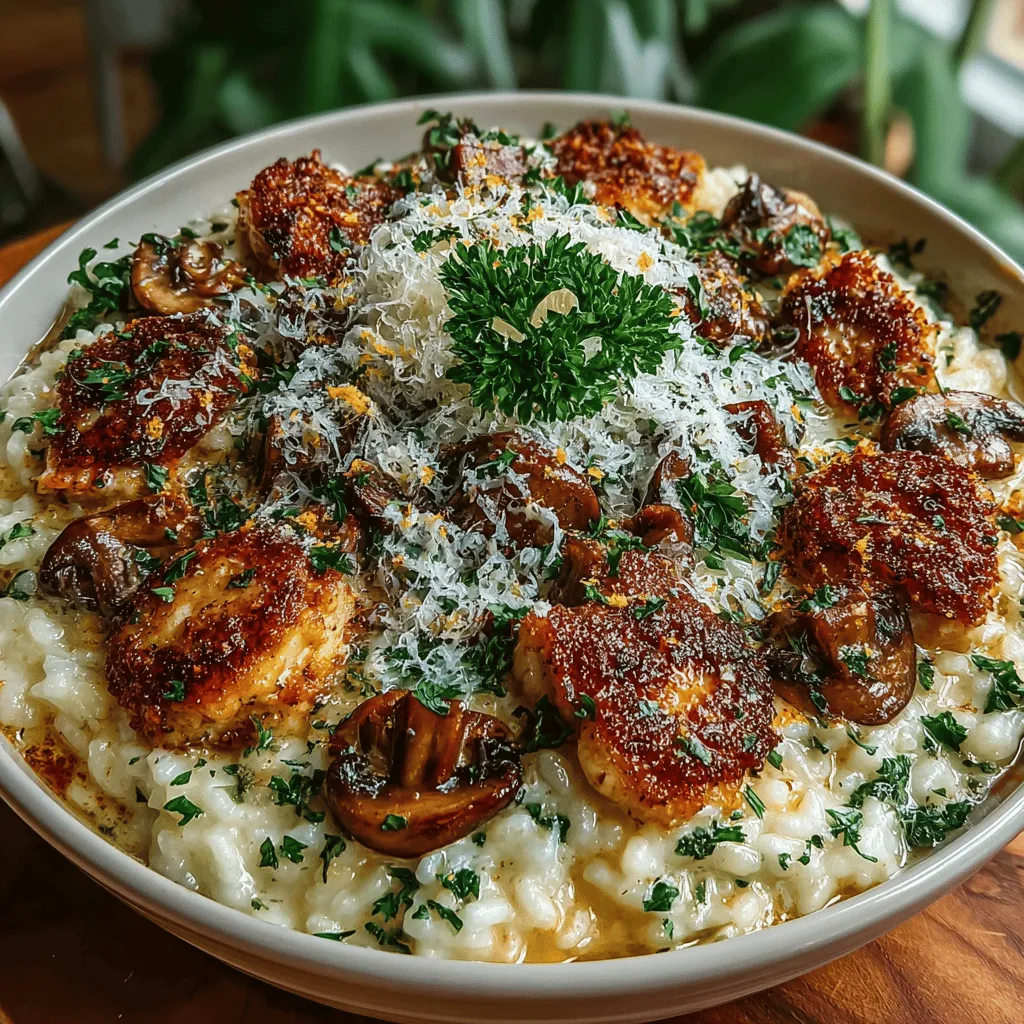Creamy Mushroom & Herb Risotto is a classic Italian dish that embodies comfort and sophistication. This dish is not only a staple in Italian cuisine but also a beloved recipe around the world, known for its rich flavors and creamy texture. Risotto is characterized by its slow-cooked rice, which absorbs flavors and becomes delectably creamy, making it a perfect choice for a cozy weeknight dinner or a special occasion gathering.
Risotto’s comforting qualities stem from its ability to meld simple ingredients into a harmonious dish. At the heart of this recipe are several key components that contribute to its unique flavor profile: Arborio rice, fresh mushrooms, aromatic herbs, and a touch of Parmesan cheese. Each ingredient plays a crucial role in creating a dish that is both satisfying and elegant, making it suitable for various dining occasions.
Understanding Risotto
What is Risotto?
Risotto is a creamy rice dish that originates from Northern Italy, particularly the regions of Lombardy and Piedmont. It is made by slowly cooking rice in broth until it reaches a creamy consistency. The technique involves gradually adding warm broth to the rice while stirring continuously, allowing the grains to release their natural starches. This process results in a dish that is not only creamy but also packed with flavor.
The Significance of Arborio Rice
One of the essential ingredients in any risotto is Arborio rice. This short-grain rice is known for its high starch content, which is crucial for achieving the desired creamy texture. Unlike other types of rice, Arborio grains are firm and plump, allowing them to absorb liquids while still maintaining an al dente bite. The unique properties of Arborio rice make it the ideal choice for risotto, as it allows for the perfect balance of creaminess and texture.
Characteristics of a Good Risotto
A well-prepared risotto should possess a few key characteristics: it should be creamy, flavorful, and have al dente rice. The creaminess comes from the starch released during cooking, while the flavor depth is developed through the gradual addition of broth, aromatics, and seasonings. Constant stirring is paramount in this process, as it helps to release starches and prevent the rice from sticking to the pan. Achieving the perfect risotto is an art that requires patience and attention, but the results are undeniably rewarding.
Key Ingredients Breakdown
Chicken Thighs
Using boneless, skinless chicken thighs in this risotto recipe adds a rich depth of flavor that enhances the overall dish. Chicken thighs are more succulent and tender compared to breast meat, which can dry out during cooking. The method of sautéing the chicken before adding it to the risotto infuses the rice with savory juices, creating a more complex and satisfying flavor profile.
Arborio Rice
As mentioned earlier, Arborio rice is the star of the risotto. Its high starch content is key to achieving the creamy texture that defines this dish. When cooked properly, Arborio rice absorbs the broth’s flavors while releasing its starch, creating a luxurious mouthfeel. The rice’s ability to hold its shape while still being creamy makes it indispensable in risotto preparation.
Mushrooms
Mushrooms are another fundamental ingredient in creamy mushroom risotto. Both cremini and button mushrooms work well in this dish, each offering a distinct flavor profile. Cremini mushrooms have a deeper, earthier taste, while button mushrooms provide a milder flavor. Nutritionally, mushrooms are low in calories and high in essential nutrients, making them a healthy addition to the dish. Their umami richness enhances the overall flavor, making each bite satisfying.
Aromatics: Onion and Garlic
The foundation of flavor in any risotto starts with the aromatics—onion and garlic. Sautéing these ingredients at the beginning of the cooking process releases their essential oils and sweetness, creating a fragrant base for the risotto. The combination of onion and garlic is classic in many cuisines, but in risotto, it sets the stage for the subsequent layers of flavor to develop.
Fresh Herbs: Thyme and Parsley
Fresh herbs like thyme and parsley elevate the flavor profile of creamy mushroom risotto. Their bright, aromatic qualities add freshness and complexity to the dish. Thyme, with its earthy notes, pairs beautifully with mushrooms, while parsley adds a pop of color and a hint of peppery flavor. While dried herbs can be used in a pinch, fresh herbs provide a vibrancy that is difficult to replicate.
Parmesan Cheese
Finally, Parmesan cheese is the finishing touch that brings all the ingredients together. Grated Parmesan adds a salty, nutty flavor and enhances the creaminess of the risotto. It’s best to use freshly grated cheese for optimal flavor and texture. The addition of Parmesan not only enriches the dish but also creates a luxurious mouthfeel that makes each bite irresistible.
In the next part of this article, we will delve into the step-by-step process of preparing creamy mushroom and herb risotto, ensuring that you can replicate this delightful dish in your own kitchen. Stay tuned for expert tips and techniques to achieve the perfect risotto every time.

Importance of Fresh versus Pre-Grated Cheese
When it comes to creating the perfect creamy mushroom and herb risotto, the type of cheese you use can make all the difference. Freshly grated cheese, such as Parmigiano-Reggiano, melts beautifully and integrates seamlessly into the risotto, enhancing its creamy texture. Pre-grated cheese, while convenient, often contains anti-caking agents that can prevent it from melting smoothly, resulting in a grainy texture. For the best results, always opt for fresh cheese.
How Cheese Contributes to the Creaminess and Umami Flavor
Cheese is not just an additive; it plays a vital role in the overall flavor profile of your risotto. Parmigiano-Reggiano, in particular, is renowned for its rich umami flavor, which deepens the savory notes of the dish. The creaminess it imparts creates that luxurious mouthfeel that risotto is famous for. As the cheese melts and combines with the other ingredients, it forms a cohesive, velvety sauce that envelops each grain of Arborio rice.
Lemon Zest
While lemon zest is an optional ingredient in this recipe, it can elevate the dish to new heights. Its bright, citrusy notes provide a refreshing contrast to the earthy flavors of the mushrooms and the richness of the cheese. A hint of lemon zest can help balance the dish, enhancing its overall flavor profile.
Why Lemon Zest is Optional and How it Can Brighten the Dish
If you’re aiming for a classic, comforting risotto, you might choose to skip the lemon zest. However, if you’re looking to add a bit of brightness and complexity, a small amount of zest can do wonders. It’s a versatile ingredient that can be adjusted according to personal preference. Start with a small amount, and feel free to add more to taste.
Step-by-Step Instructions
Preparing the Chicken
Begin by preparing your chicken. Season the chicken breasts with salt and pepper to enhance their natural flavors.
1. Heat a tablespoon of olive oil in a large skillet over medium-high heat.
2. Once the oil is shimmering, add the chicken breasts. Sauté for about 5-7 minutes on each side until cooked through and golden brown.
3. Use a meat thermometer to ensure the internal temperature reaches 165°F (75°C).
4. Once cooked, remove the chicken from the skillet and let it rest for a few minutes before slicing it into bite-sized pieces. This resting period helps retain the juices, ensuring moist and flavorful chicken.
Sautéing Vegetables
Next, it’s time to sauté the vegetables, which is crucial for building flavor.
1. In the same skillet used for the chicken, add another tablespoon of olive oil if necessary. Reduce the heat to medium.
2. Add finely chopped onions and sauté them for about 2-3 minutes until they become translucent, stirring frequently to prevent burning.
3. Incorporate minced garlic, cooking for an additional minute until fragrant. Be careful not to let the garlic brown, as it can become bitter.
Tips for Cooking Mushrooms to Avoid Sogginess
When adding the mushrooms, be mindful of their water content. To prevent sogginess:
– Use a mix of fresh mushrooms, such as cremini and shiitake, for a variety of flavors and textures.
– Avoid overcrowding the pan. If necessary, sauté the mushrooms in batches.
– Allow them to cook undisturbed for a few minutes before stirring. This helps them develop a nice golden color and enhances their flavor.
Toasting the Rice
Toasting the Arborio rice is a crucial step that enhances its flavor.
1. Once the mushrooms have released their moisture and are nicely browned, add the Arborio rice to the skillet.
2. Stir the rice for about 1-2 minutes, allowing it to absorb the oil and flavors from the vegetables. You’ll notice a slight translucence at the edges of the grains when they are toasted properly.
Deglazing and Simmering
Now, let’s focus on deglazing the pan.
1. Pour in a splash of white wine, scraping the bottom of the skillet with a wooden spoon to lift any flavorful brown bits stuck to the pan. This process adds depth to your risotto.
2. Allow the wine to simmer and reduce for about 1-2 minutes until most of the liquid has evaporated.
Cooking the Risotto
The heart of making risotto lies in the gradual addition of broth.
1. Begin by adding a ladle of warm chicken or vegetable broth to the rice mixture, stirring constantly.
2. Allow the rice to absorb the broth before adding more, repeating this process until the rice is al dente—typically about 18-20 minutes.
3. Taste the rice periodically, aiming for a creamy texture with a slight bite in the center.
Recognizing When the Risotto is Done: Texture and Taste Indicators
The ideal risotto should be creamy and smooth with a slightly thick consistency. The rice should be tender yet firm to the bite. If you find it too thick, feel free to add more broth until you reach your desired consistency.
Combining Ingredients
Once the risotto reaches the perfect texture, it’s time to combine the ingredients.
1. Remove the skillet from heat and gently fold in the sliced chicken, a few tablespoons of butter, and a generous handful of freshly grated cheese.
2. Stir until everything is well-combined and the butter has melted, creating a luscious sauce.
3. Adjust seasoning with salt and pepper to taste, ensuring the flavors are balanced.
Garnishing and Serving
Presentation is key to elevating your risotto experience.
1. Serve the risotto in shallow bowls for a restaurant-quality look.
2. Garnish with additional cheese, freshly chopped herbs (like parsley or thyme), and a sprinkle of lemon zest if desired.
3. For an extra touch, drizzle a little extra virgin olive oil over the top before serving.
Nutritional Information
Creamy mushroom and herb risotto is not just delicious; it also offers several nutritional benefits.
1. Nutritional Overview: This dish is rich in carbohydrates from the Arborio rice, providing a great energy source. Mushrooms are low in calories and high in vitamins and minerals, particularly B vitamins, selenium, and potassium.
2. Caloric Content: A standard serving of risotto is around 400-500 calories, depending on the portion size and ingredients used.
3. Healthy Alternatives: For a lighter version, consider substituting the chicken broth with vegetable broth for a vegetarian option. You can also reduce the amount of cheese or use a low-fat cheese to cut back on calories while still enjoying the creamy texture.
Conclusion
Creamy mushroom and herb risotto is truly a dish that embodies comfort and indulgence. Its rich flavors and creamy texture make it a perfect centerpiece for both everyday meals and special occasions. Whether you’re celebrating a milestone or simply enjoying a cozy night in, this risotto is sure to impress.
We encourage you to try making this creamy mushroom and herb risotto at home. Not only will you enjoy the delightful culinary experience, but you’ll also have the joy of sharing it with loved ones. Cooking is about creating memories, and this dish is destined to be a favorite at any table. Remember, the best meals are those made with care, love, and the intention to bring people together. Happy cooking!


